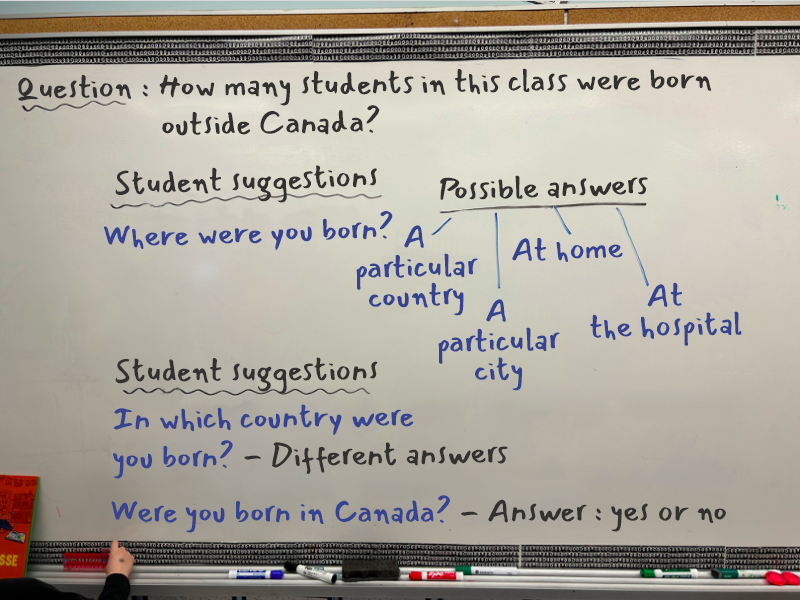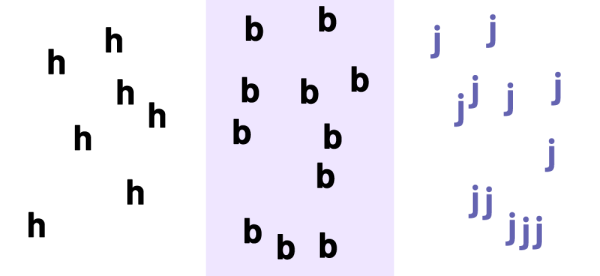D1.2 Collect data through observations, experiments, and interviews to answer questions of interest that focus on two pieces of information, and organize the data in two-way tally tables.
Activity 1: Where Were You Born?
In a discussion, a student asks how many students in the class were born outside of Canada. The teacher takes the opportunity to point out that this is a good question of interest. The teacher then suggests that the students conduct a survey and asks them how the survey question could be worded.
The teacher writes some of the propositions on the board and encourages the students to think about possible interpretations of each. For example, one of the questions proposed is: "Where were you born?" The teacher then asks the students if they think the question is clear. Most seem to think so. The teacher then asks them to indicate the kind of answer that could be obtained by this question. Some indicate that one should obtain the name of a country, while others rather think of a city name. There is even a student who indicates that we could answer either at home or at the hospital. The students then realize that the question is subject to interpretation and that it would benefit from being reformulated in order to better target the type of answer desired. A student asks the question "In which country were you born?"; another suggests "Were you born in Canada?".
The previous situation highlights the importance of educators encouraging students to check with a few respondents to see if the wording of a survey question actually produces the kind of response expected. They can also address the idea of the large number of responses a question can generate, which could make collecting, recording, and analyzing the data more difficult. In such cases, it might be beneficial to word a question in a multiple-choice format.

Source: translated from Guide d’enseignement efficace des mathématiques, de la maternelle à la 3e année, Traitement des données et probabilité, p. 63.
Activity 2: My Reading Preferences
Students in a Grade 2 class want to know the reading preferences of elementary school students in order to suggest what kinds of books should be purchased for the school library. They decide to conduct a survey with these students.
Here are some examples of student-proposed survey questions with possible observations.
| Question | Observations |
|---|---|
| What is your favourite kind of book? | This question can be difficult to understand if one does not know how to describe different kinds of books. It can therefore generate quite a large number of different responses and complicate the task of drawing conclusions about students' preferences. |
| Do you like to read fairy tales? | This question is clear and does not seem open to interpretation. In addition, it facilitates data collection since the only two anticipated answers are yes and no. It shows how many students like or dislike fairy tales, but it gives no information about students' preferences for other kinds of books. |
What would be your first choice of book among the following?
|
This multiple-choice question reduces the number of possible answers, allowing for more effective organization and interpretation, and limits the choice to text genres that students are familiar with from their primary school years. |
Source: translated from Guide d’enseignement efficace des mathématiques, de la maternelle à la 3e année, Traitement des données et probabilité, p. 64.
Activity 3: Variability Factors
The students in a Grade 3 class want to organize activities for Grade 1 students, so they decide to survey all Grade 1 students to determine their preference for indoor or outdoor activities.
The teacher takes the opportunity to encourage the students to think about the conditions under which the survey will be conducted and their possible impact by asking questions such as:
- In your opinion, is it better to conduct the survey in the morning or just before lunch? (It is better to conduct the survey in the morning because just before lunch, students may be anxious to go outside to play and may choose outdoor activities)
- Is today a good day to conduct the survey? (Since it is very cold outside, it may not be the best day because students may not feel like going outside and may choose to do the activities indoors.)
Source: translated from Guide d’enseignement efficace des mathématiques, de la maternelle à la 3e année, Traitement des données et probabilité, p. 65.
Activity 4: A Three-Column Table (Collecting and Recording Data)
A team wants to determine which of the following activities the students in the class prefer: playing field hockey, riding a bike, or practicing judo. To record the responses team members prepare a table with three columns, each column being reserved for one activity. As students answer the survey question, they write the first letter corresponding to the chosen activity in the appropriate column.

Source: translated from Guide d’enseignement efficace des mathématiques, de la maternelle à la 3e année, Traitement des données et probabilité, p. 72.
